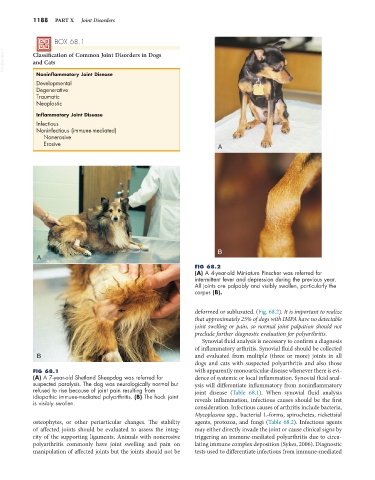Page 1216 - Small Animal Internal Medicine, 6th Edition
P. 1216
1188 PART X Joint Disorders
BOX 68.1
VetBooks.ir Classification of Common Joint Disorders in Dogs
and Cats
Noninflammatory Joint Disease
Developmental
Degenerative
Traumatic
Neoplastic
Inflammatory Joint Disease
Infectious
Noninfectious (immune-mediated)
Nonerosive
Erosive
A
B
A
FIG 68.2
(A) A 4-year-old Miniature Pinscher was referred for
intermittent fever and depression during the previous year.
All joints are palpably and visibly swollen, particularly the
carpus (B).
deformed or subluxated. (Fig. 68.2). It is important to realize
that approximately 25% of dogs with IMPA have no detectable
joint swelling or pain, so normal joint palpation should not
preclude further diagnostic evaluation for polyarthritis.
Synovial fluid analysis is necessary to confirm a diagnosis
of inflammatory arthritis. Synovial fluid should be collected
B and evaluated from multiple (three or more) joints in all
dogs and cats with suspected polyarthritis and also those
FIG 68.1 with apparently monoarticular disease whenever there is evi-
(A) A 7-year-old Shetland Sheepdog was referred for dence of systemic or local inflammation. Synovial fluid anal-
suspected paralysis. The dog was neurologically normal but ysis will differentiate inflammatory from noninflammatory
refused to rise because of joint pain resulting from joint disease (Table 68.1). When synovial fluid analysis
idiopathic immune-mediated polyarthritis. (B) The hock joint
is visibly swollen. reveals inflammation, infectious causes should be the first
consideration. Infectious causes of arthritis include bacteria,
Mycoplasma spp., bacterial L-forms, spirochetes, rickettsial
osteophytes, or other periarticular changes. The stability agents, protozoa, and fungi (Table 68.2). Infectious agents
of affected joints should be evaluated to assess the integ- may either directly invade the joint or cause clinical signs by
rity of the supporting ligaments. Animals with nonerosive triggering an immune-mediated polyarthritis due to circu-
polyarthritis commonly have joint swelling and pain on lating immune complex deposition (Sykes, 2006). Diagnostic
manipulation of affected joints but the joints should not be tests used to differentiate infectious from immune-mediated

